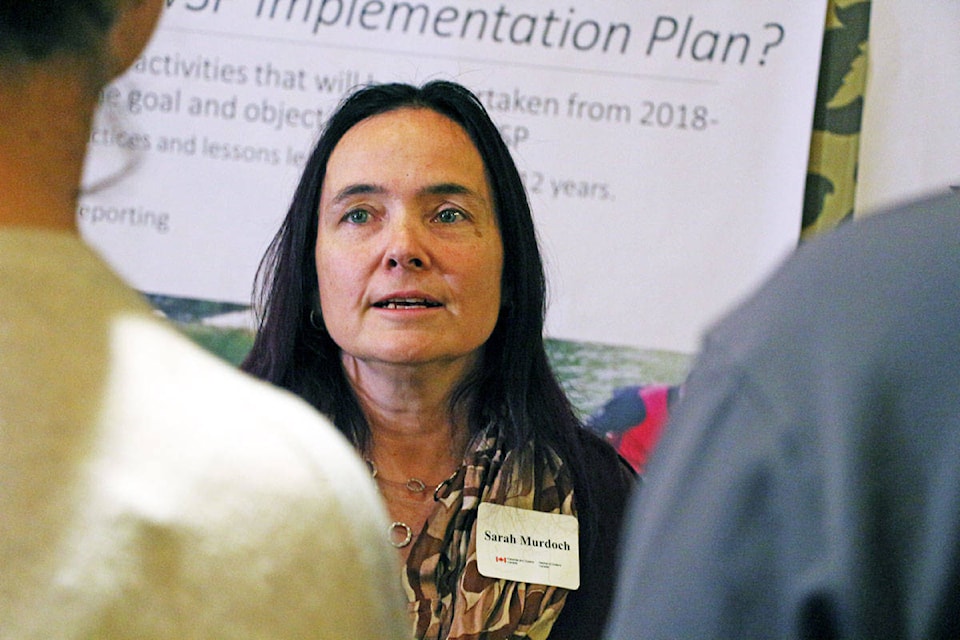Gaps in how the Wild Salmon Policy is being implemented across the Pacific coast has led to community consultations in B.C. and the Yukon.
Fisheries and Oceans Canada (DFO) held meetings in Prince Rupert on Oct. 24 and Smithers on Oct. 25, to gather feedback on how to improve the policy that came into effect in 2005.
“Over the last 12 years you can’t point to one place to see the work that’s collectively been done and also we don’t really have a measure, in terms of a yardstick, to show how much closer are we to the overarching goal of bringing back and restoring healthy wild salmon populations,” said Sarah Murdoch, regional director for policy and economic analysis for DFO.
In November 2016, DFO held consultations in Prince Rupert, and other B.C. communities, to gather initial recommendations for the draft a plan. What they heard was strong support for the Wild Salmon Policy, but that more stock assessment needs to be done especially in areas where data is lacking — and there needs to be quicker action for at-risk stocks.
A study published this summer in the Canadian Journal of Fisheries and Aquatic Sciences, reviewed the policy and examined its shortfalls. The study states that only 29 per cent of 634 annual and 134 periodic spawning streams recommended for monitoring were monitored between 2007-2014.
SkeenaWild Conservation Trust, based in Terrace, took part in the study. Executive director Greg Knox said the study, Canada’s Wild Salmon Policy: an assessment of conservation progress in British Columbia, found that assessment activity has dropped since the policy was implemented.
“You really can’t do anything until you know what’s going on, how many fish are coming back up the river,” Knox said.
What DFO has found from its work related to the policy is there are 460 genetically unique salmon populations across the Pacific Region — which Murdoch said is both challenging and inspiring — and effectively implementing the policy can’t be done by DFO alone.
“The federal government is happy to have a leadership role in it but certainly we have to share that with other groups and there are a lot of good projects and things happening at the community level, which we’re hoping to build on,” Murdoch said.
Managing sockeye stocks has been another challenge. In June, recreational fishing for sockeye salmon in the Skeena River was closed for the 2017 season. In 2009, low sockeye stocks in the Fraser River triggered the Cohen Commission. One of the 75 recommendations from the inquiry was the need for a detailed implementation plan for the Wild Salmon Policy.
RELATED: RECREATIONAL SALMON FISHING SHUT DOWN
“It is quite discouraging and alarming in some ways how hard a time a lot of the stocks are having these days despite a lot of good efforts,” Murdoch said.
She recognized that there are some elements out of DFO’s control, including climate change and water temperatures.
“All the more reason to collectively pull all the science work that is being done, have that information available to anyone who wants it, which is one of the big initiatives that we’re planning, and making sure we’re pulling together and doing things in a coordinated way,” she said.
At the Prince Rupert consultation at the Crest Hotel, Joy Thorkelson, the northern representative for the United Fishermen and Allied Workers’ Union, said that she’s pleased with the presentation of the plan. However, she wants to see social considerations included in the plan as well as economic.
“I expect there to be a comment somewhere that if you adopt a policy it includes the negative impacts to an identifiable group of people. There needs to be a policy on how to handle that, and there isn’t,” she said.
DFO anticipates to roll out the draft implementation plan for a five year period between 2018-2022, with a focus on more stock assessment work and working with groups in the region to prioritize certain populations of salmon.
Public feedback on the plan is encouraged through an online workbook that can be accessed here.
With files from Rod Link
shannon.lough@thenorthernview.com
Like us on Facebook and follow us on Twitter
